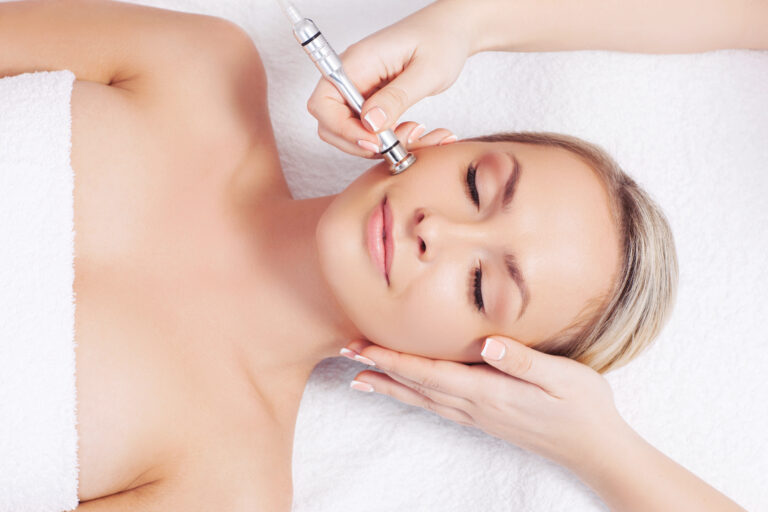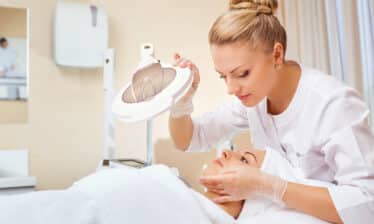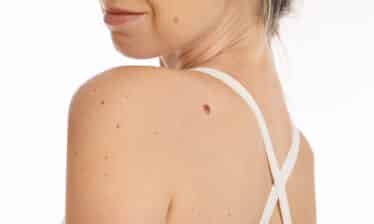Mild skin blemishes, from fine lines and wrinkles to hyperpigmentation from acne, blackheads, and a dull complexion, are very common. Microdermabrasion could be the right treatment to help you achieve a brighter, smoother complexion.
What Is Microdermabrasion?
Microdermabrasion is a facial treatment performed by dermatologists and trained aestheticians to remove the outer layer of skin using gentle abrasion. This can help to even out skin tone, reduce scarring or discoloration, and brighten your complexion. There are a few microdermabrasion procedures, but each will result in fresher, exfoliated skin.
A microdermabrasion procedure is usually quick and painless. Depending on your skin goals, you may need several treatments to achieve your desired results, but even one treatment will provide noticeably softer, smoother, and brighter skin.
Microdermabrasion Benefits
There are many benefits to a microdermabrasion procedure. These include:
- Reducing the appearance of age spots
- Clearing blackheads
- Lightening hyperpigmented skin
- Rejuvenating your face with exfoliation
- Reducing the appearance of stretch marks
- Improving fine lines and wrinkles
- Reducing the appearance of large pores and clearing any congestion
- Treating minor acne and reducing the appearance of dark spots from acne
- Thickening your collagen, leaving your complexion looking younger
The number of treatments required will vary based on your skin goals. The dermabrasion treatments build on each other so that a series of treatments will result in improved skin texture and tone and a reduction in blemishes.
You might need anywhere from one to ten or more treatments scheduled one to two weeks apart. Your dermatologist or aesthetician will recommend the best treatment options for your skin.
It’s worth noting that, though it can help with mild acne from clogged pores, microdermabrasion is usually not recommended if you have moderate to severe acne or cystic acne. The process can irritate acne that is already inflamed.
Microdermabrasion is also not an effective treatment for deep acne scars or raised acne scars.
Microdermabrasion Procedure
There are a few options for microdermabrasion procedures. Each type uses a handheld device to exfoliate the top layer of your skin gently. They can be performed by your dermatologist or an aesthetician and are often combined with other spa or facial treatments.
The different types of microdermabrasion procedures are:
- Crystal microdermabrasion
- Diamond microdermabrasion
- Hydradermabrasion
No matter which option you choose, each microdermabrasion procedure is quick. One microdermabrasion treatment usually lasts about 15 to 30 minutes, making it a fast, easy option to improve your skin’s appearance.
Crystal microdermabrasion
This type of microdermabrasion is like a powerful scrub. Your dermatologist or aesthetician will use a device that blasts your skin with tiny crystals and then suctions up the crystals along with dead skin cells.
It’s a simple but effective way to exfoliate and leave you with smoother, softer skin after just one treatment.
Typically, crystal microdermabrasion treatments use aluminum oxide crystals, but other types might include magnesium oxide, sodium bicarbonate, or sodium chloride.
Diamond microdermabrasion
A newer type of microdermabrasion, diamond microdermabrasion does not use crystals to exfoliate your skin. Instead, your dermatologist or aesthetician will pass a wand with a diamond tip across your skin.
The diamond works the same way as the crystals to gently abrade your skin, and the dead skin cells are vacuumed up through the same wand.
This microdermabrasion procedure does not leave any stray crystals on the skin, although the end effect of smoother, exfoliated skin is the same as crystal microdermabrasion.
Hydradermabrasion
This type of microdermabrasion is the newest and combines exfoliation treatment with hydration.
It involves first cleansing the skin and gently exfoliating with a skin peel, then using suction to remove dirt and debris that may be clogging your pores. Your practitioner will then apply nourishing moisturizers to replenish and protect your skin and finish the treatment with a series of antioxidants and peptides.
Side Effects of Microdermabrasion
Microdermabrasion is very safe. Any side effects of the procedure should be minimal and temporary.
You might experience some pinkness or redness for a few hours after treatment, but it should fade quickly. It might feel like a mild sunburn for a few days. Other side effects include:
- Tenderness, puffiness, or minor bruising
- Dry or flaking skin
- Increased sensitivity to the sun
- Mild abrasions
- Cold sores, if you have had them before
Make sure to apply moisturizer and sunscreen after a microdermabrasion treatment. It’s also a good idea to limit sun exposure after treatment since your new skin will be more sensitive to harmful UV rays at first.
If toners, acne creams, or cleansers cause stinging or burning sensations when applied after a microdermabrasion treatment, just refrain from using them for a day.
Cost of Microdermabrasion
A typical microdermabrasion treatment can cost anywhere from $75 to $300 per treatment.
Remember, you may need multiple treatment sessions to achieve your desired skin care goals, so don’t be afraid to shop around for the best treatment options for you.
Talk to your dermatologist or aesthetician about your skin care goals so you can plan for the right number of treatments for you.
Learn More About Microdermabrasion
Microdermabrasion is a safe, easy treatment to address mild skin blemishes and deeply nourish and exfoliate your skin. Make sure to talk to your dermatologist or healthcare provider to determine if it will be your best treatment option. My Skin Treatment is here to provide you with physician-reviewed resources about skin-related topics.






